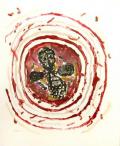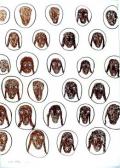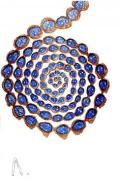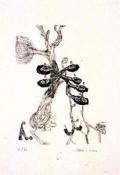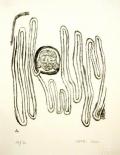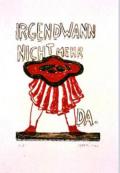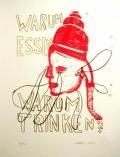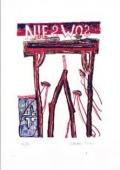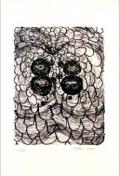enquiries@muka.co.nz
ASSIG, Martin
Nationality: Germany
Website: Website
German artist
Born in Schwelm 1959
Lives and works in Berlin
"I find it reassuring when I look at something I don't understand..."
Most people want their environment to be reassuring and find comfort when their location is familiar, with images from their past, and tunes they know so well. Not so Martin Assig.
Born in 1959 in Westfalen, Germany, the son of a doctor, he first worked in Berlin. But after the wall came down, when the old horse stable in which he had his studio was earmarked for redevelopment, Assig found an old pub in Brädikow one hour's drive from Berlin where he lives and works now.
The artist claims that the total concentration on his work more or less changes him into a different kind of person: Dr. Jekyll and Mr. Hyde.
A pleasant outgoing person in everyday life, he produces these dangerously dark paintings. With bewilderment he observes a wounded bleeding world and takes it as the starting point and basis of his work. And yet he is in no way the archetypal tormented artist.
Martin Assig's problem is in the first place aesthetic: he is searching for the meaning of painting. The search began when he was 15, and in his parents’ house discovered three art books – one about Albert Dürer, one about Ernest Barlach and one about Renaissance art. Later Francesco de Zurbaran, Paolo Veronese, Titian and Frida Kahlo became his idols.
An early try at an erotic drawing had his parents in shock. At High School he was given a separate room as a personal studio and here experimented with linocuts and other printing techniques on subjects such as war memorial monuments, war invalids, concentration camp images and illustrations of Bertold Brecht texts.
Quite early Assig rediscovered the ancient encaustic technique of painting with hot wax. This gave his works a rich colour and a transparent quality, also allowing him to incorporate fabric and paper into the work. The texture and patterns at first seem friendly and reassuring, but often a closer look makes you notice that the patterns are built from disturbing images, weapons, skulls, etc.
The painter's work consists of a long process of intensification and composition, in this way gradually alienating the initial image. He is only satisfied "when the image has become so strange that I can look at it and judge it again".
The meaning of painting seems then reworking an initial image from a disturbing world to the point at which it offers even its creator opportunities for renewed discovery.
Born in Schwelm 1959
Lives and works in Berlin
"I find it reassuring when I look at something I don't understand..."
Most people want their environment to be reassuring and find comfort when their location is familiar, with images from their past, and tunes they know so well. Not so Martin Assig.
Born in 1959 in Westfalen, Germany, the son of a doctor, he first worked in Berlin. But after the wall came down, when the old horse stable in which he had his studio was earmarked for redevelopment, Assig found an old pub in Brädikow one hour's drive from Berlin where he lives and works now.
The artist claims that the total concentration on his work more or less changes him into a different kind of person: Dr. Jekyll and Mr. Hyde.
A pleasant outgoing person in everyday life, he produces these dangerously dark paintings. With bewilderment he observes a wounded bleeding world and takes it as the starting point and basis of his work. And yet he is in no way the archetypal tormented artist.
Martin Assig's problem is in the first place aesthetic: he is searching for the meaning of painting. The search began when he was 15, and in his parents’ house discovered three art books – one about Albert Dürer, one about Ernest Barlach and one about Renaissance art. Later Francesco de Zurbaran, Paolo Veronese, Titian and Frida Kahlo became his idols.
An early try at an erotic drawing had his parents in shock. At High School he was given a separate room as a personal studio and here experimented with linocuts and other printing techniques on subjects such as war memorial monuments, war invalids, concentration camp images and illustrations of Bertold Brecht texts.
Quite early Assig rediscovered the ancient encaustic technique of painting with hot wax. This gave his works a rich colour and a transparent quality, also allowing him to incorporate fabric and paper into the work. The texture and patterns at first seem friendly and reassuring, but often a closer look makes you notice that the patterns are built from disturbing images, weapons, skulls, etc.
The painter's work consists of a long process of intensification and composition, in this way gradually alienating the initial image. He is only satisfied "when the image has become so strange that I can look at it and judge it again".
The meaning of painting seems then reworking an initial image from a disturbing world to the point at which it offers even its creator opportunities for renewed discovery.


